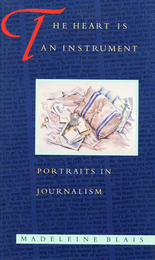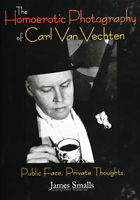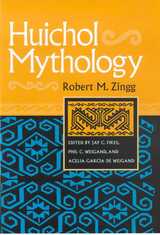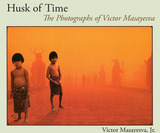122 books about Portraits and 4
start with H
122 books about Portraits and 4
122 books about Portraits
4 start with H start with H
4 start with H start with H

The Heart Is an Instrument
Portraits in Journalism
Madeleine Blais
University of Massachusetts Press, 1994
From the foreword by Geneva Overholser.
What is it about really fine writers, how they delight, intrigue, compel us?
Style, you say. But style is not something you begin with. Rather, it's what you end up with, a result of far more fundamental traits. Traits such as an ear and an eye and a heart, traits that Madeliene Blais has honed superbly well.
This is a book well named: The Heart Is an Instrument: Portraits in Journalism. The heart is surely first among Blais's gifts. Whether she is writing about the famous--playwright tennessee Williams, novelist Mary Gordon--or about the least elevated among us--a teenage prostitute infected with the AIDS virus, a homeless schizophrenic--she brings to her subjects an incomparable empathy.
What is it about really fine writers, how they delight, intrigue, compel us?
Style, you say. But style is not something you begin with. Rather, it's what you end up with, a result of far more fundamental traits. Traits such as an ear and an eye and a heart, traits that Madeliene Blais has honed superbly well.
This is a book well named: The Heart Is an Instrument: Portraits in Journalism. The heart is surely first among Blais's gifts. Whether she is writing about the famous--playwright tennessee Williams, novelist Mary Gordon--or about the least elevated among us--a teenage prostitute infected with the AIDS virus, a homeless schizophrenic--she brings to her subjects an incomparable empathy.
[more]

The Homoerotic Photography of Carl Van Vechten
Public Face, Private Thoughts
James Smalls
Temple University Press, 2006
Carl Van Vechten (1880-1964) was perhaps the most notorious white patron of the arts of black America, particularly during the Harlem Renaissance. In 1932, he gave up a career as a theater critic and a novelist of light fiction to become a full-time amateur photographer. His photographs of the era's celebrated African American cultural figures are well-known, but until recently his private, homoerotic interracial photographs were sealed in an archive. Author James Smalls considers how these images relate to Van Vechten's public persona and private desires. He discusses the interracial photographs in the context of white privilege and exotic tourism, primitivism's relation to modernism, camp sensibility and theatricality, and the vibrancy of underground gay visual culture during periods of political oppression. He also considers contemporary viewers' conflicting responses to the eroticized black male body in Van Vechten's and later twentieth-century photography. This original and provocative book embraces transracial voyeuristic pleasure while acknowledging the negative political implications of that pleasure. Amply illustrated with 60 pioneering duotones, The Homoerotic Photography of Carl Van Vechten celebrates the sensual nude male form with both candor and reverence, offering a rare glimpse into the private domain of the master photographer and his handsome subjects.
[more]

Huichol Mythology
Robert M. Zingg; Edited by Jay C. Fikes, Phil C. Weigand, and Acelia García de Weigand
University of Arizona Press, 2004
Best known for their ritual use of peyote, the Huichol people of west-central Mexico carried much of their original belief system into the twentieth century unadulterated by the influence of Christian missionaries. Among the Huichol, reciting myths and performing rituals pleases the ancestors and helps maintain a world in which abundant subsistence and good health are assured.
This volume is a collection of myths recorded by Robert Zingg in 1934 in the village of Tuxpan and is the most comprehensive record of Huichol mythology ever published. Zingg was the first professional anthropologist to study the Huichol, and his generosity toward them and political advocacy on their behalf allowed him to overcome tribal sanctions against divulging secrets to outsiders. He is fondly remembered today by some Huichols who were children when he lived among them. Zingg recognized that the alternation between dry and wet seasons pervades Huichol myth and ritual as it does their subsistence activities, and his arrangement of the texts sheds much light on Huichol tradition. The volume contains both aboriginal myths that attest to the abiding Huichol obligation to serve ancestors who control nature and its processes, and Christian-inspired myths that document the traumatic effect that silver mining and Franciscan missions had on Huichol society.
First published in 1998 in a Spanish-language edition, Huichol Mythology is presented here for the first time in English, with more than 40 original photographs by Zingg accompanying the text. For this volume, the editors provide a meticulous historical account of Huichol society from about 200 A.D. through the colonial era, enabling readers to fully grasp the significance of the myths free of the sensationalized interpretations found in popular accounts of the Huichol. Zingg’s compilation is a landmark work, indispensable to the study of mythology, Mexican Indians, and comparative religion.
This volume is a collection of myths recorded by Robert Zingg in 1934 in the village of Tuxpan and is the most comprehensive record of Huichol mythology ever published. Zingg was the first professional anthropologist to study the Huichol, and his generosity toward them and political advocacy on their behalf allowed him to overcome tribal sanctions against divulging secrets to outsiders. He is fondly remembered today by some Huichols who were children when he lived among them. Zingg recognized that the alternation between dry and wet seasons pervades Huichol myth and ritual as it does their subsistence activities, and his arrangement of the texts sheds much light on Huichol tradition. The volume contains both aboriginal myths that attest to the abiding Huichol obligation to serve ancestors who control nature and its processes, and Christian-inspired myths that document the traumatic effect that silver mining and Franciscan missions had on Huichol society.
First published in 1998 in a Spanish-language edition, Huichol Mythology is presented here for the first time in English, with more than 40 original photographs by Zingg accompanying the text. For this volume, the editors provide a meticulous historical account of Huichol society from about 200 A.D. through the colonial era, enabling readers to fully grasp the significance of the myths free of the sensationalized interpretations found in popular accounts of the Huichol. Zingg’s compilation is a landmark work, indispensable to the study of mythology, Mexican Indians, and comparative religion.
[more]

Husk of Time
The Photographs of Victor Masayesva
Victor Masayesva, Jr.; Introduction by Beverly R. Singer
University of Arizona Press, 2006
Photographer and filmmaker Victor Masayesva, Jr., was raised in the Hopi village of Hotevilla and was educated at the Horace Mann School in New York, Princeton University, and the University of Arizona. His immersion in photographic experimentation embraces a projection of stories and symbols, natural objects, and locations both at Hopi and worldwide. His work has been exhibited internationally, and he is perhaps best known for his feature-length film Imagining Indians. For Masayesva, photography is a discipline that he approaches in a manner similar to the way that he was taught about himself and his clan identity. As he navigates his personal associations with Hopi subject matter in varied investigations of biology, ecology, humanity, history, planetary energy, places remembered, and musings on things broken and whole, he has created an extraordinary visual cosmography. In this compilation of his photographic journey, Masayesva presents some of the most important and vibrant images of that visual quest and reflects on them in provocative essays.
[more]
READERS
Browse our collection.
PUBLISHERS
See BiblioVault's publisher services.
STUDENT SERVICES
Files for college accessibility offices.
UChicago Accessibility Resources
home | accessibility | search | about | contact us
BiblioVault ® 2001 - 2024
The University of Chicago Press









